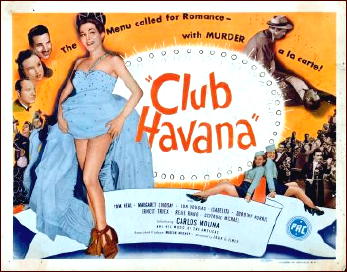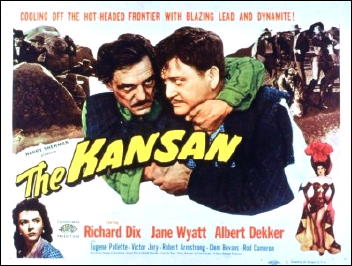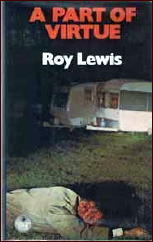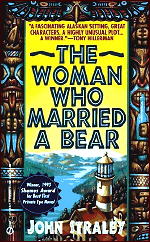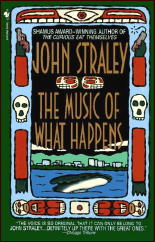November 2010
Monthly Archive
Tue 30 Nov 2010
THE BACKWARD REVIEWER
William F. Deeck
ALICE CAMPBELL – They Hunted a Fox. Scribner, US, hardcover, 1940. Originally published in the UK: Collins Crime Club, hc, 1940.
Tom Boldre, owner of Chenrys, an estate in deep financial trouble, has no interest other than horses and, in season, fox hunting. On one hunt, Boldre falls from his horse and suffers a concussion. Two weeks later he falls again and breaks a thigh, which, it seems, causes a heart attack and death.
When Boldre’s tenant who had helped him on his first fall is shot and killed shortly after Boldre dies, Scotland Yard, in the form of Inspector Headcorn, is called in. Headcorn is a dogged investigator, always seeming to be on the spot when something turns up. He discovers that Boldre died in a most unusual and unnatural way.
Despite the attempts by all concerned to conceal evidence and mislead Headcorn, putting themselves and others in jeopardy since the murderer is, if I may put it this way, foxy, the killer is unmasked. Above average in plot and writing.
— From The MYSTERY FANcier, Vol. 11, No. 4, Fall 1989.
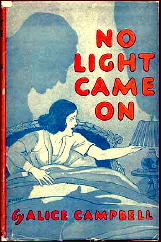
Bibliographic Data: Alice Campbell, 1887-1976?, was the author of 19 mystery and detective novels between 1928 and 1950. Inspector Headcorn was in five of them:
Death Framed in Silver. Collins 1937 [Colin Ladbroke also appears]
They Hunted a Fox. Collins 1940 [Alison Young & Colin Ladbroke also appear]
No Murder of Mine. Collins 1941
The Cockroach Sings. Collins 1946
The Bloodstained Toy. Collins 1948 [Tommy Rostetter also appears]
I can’t tell you anything more about Campbell’s other series characters. Alison Young and Colin Ladbroke appear together in one book without Headcorn, while Tommy Rostetter is also the star of three solo adventures. The twosome of Geoffrey MacAdam and Catherine West appear in two others, including No Light Came On, 1942, but neither with Headcorn.
There is very little additional information about Alice Campbell on the Internet. There is a list of her mysteries here, and another short mention of her can be found earlier on this blog in the comments following this post.
Sun 28 Nov 2010
REVIEWED BY WALTER ALBERT:
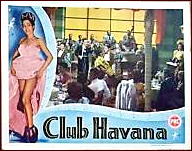
CLUB HAVANA. PRC, 1945. Margaret Lindsay, Tom Neal, Don Douglas, Marc Lawrence, Eddie Hall, Renie Riano, Ernest Truex, Eric Sinclair, Gertrude Michael, Paul Cavanagh, Pedro DeCordoba, Carlos Malina, and Isabelita. Director: Edgar G. Ulmer. Shown at Cinefest 28, Syracuse NY, March 2008.
The program notes referred to this as a bargain basement Grand Hotel, with direction by Ulmer continuing his tradition of making sparsely budgeted films look good. (Maybe somebody should do a book on directors who were consistently better than the films they directed.)

The setting is a vaguely Art Deco night club, with a Latin band, and undistinguished musical numbers that add little to the interlocking stories.
The main plot involves a gangster (Marc Lawrence), suspected of a murder but released when a witness goes missing.
Club Havana is his hangout and he learns that a young musician (Eric Sinclair) saw the murder, has called the police and will identify Lawrence when they arrive.
The mounting suspense as Lawrence arranges for a hit on Sinclair is interspersed with music and comic turns (rich, ugly widow Renie Riano agreeing to marry gigolo Paul Cavanagh and both knowing exactly what they’re getting into; Ernest Truex attempting a reunion with his indifferent wife) prolonging the thin plot.
This is entertainment by the ’40s numbers, with a little cinematic gloss provided by Ulmer’s ingenious camera and smooth direction of his competent cast.
Editorial Comment: This somewhat hard to find movie has also been reviewed by James Reasoner over on his blog.
Sun 28 Nov 2010
REVIEWED BY DAN STUMPF:
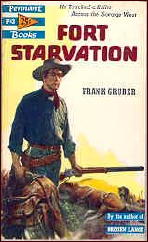
â— FRANK GRUBER – Fort Starvation. Rinehart & Co., hardcover, 1953. Pennant P43, paperback, 1954; Bantam, pb, 1970. Filmed as Backlash: Universal International, 1956.
â— BORDEN CHASE – Red River. Bantam #205, paperback, September 1948. Originally published as Blazing Guns on the Chisholm Trail: Random House, hardcover, 1948. Filmed under the paperback title: United Artists, 1948.
Some time back I watched a modest little western/mystery called Backlash from 1956 where Richard Widmark goes looking for the owlhoot what left his Paw to be murdered by Injuns, with surprisingly dramatic results.
Well, the credits tell us the screenplay by Borden Chase was based on a novel by Frank Gruber, but it took a lot of looking to figure out the book they were talking about is Fort Starvation (Rinehart, 1953) and it’ s interesting to see how it served as the starting-point for the movie.
Gruber was a competent screenwriter, with films like Mask of Dimitrios (1944) and Dressed to Kill (1946) to his credit, but he never rose above competence, and that’s the kind of book Fort Starvation is: adequate but nothing special.
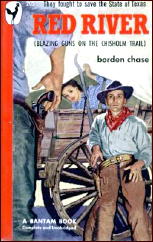
John Slater gallops across the West sifting the ground for clues, re-checking witnesses, going undercover at one point with an outlaw band, and generally embroiling himself in a panoply of western cliches till Gruber arbitrarily decides to wrap things up with a “surprise” considerably less dramatic than that of the film.
The characters are never more colorful than the black-and-white prose, nor deeper than the thickness of pulp paper, and while I’m glad I satisfied my morbid curiosity tracking down and reading this thing, I can’t recommend it to anyone else.
After reading this, I picked up Borden Chase’s novel Red River, originally serialized in the Saturday Evening Post as “Blazing Guns on the Chisolm Trail.”
If you’ve seen the film, the basics of the story are all there in the book, but Chase’s writing is nothing like the wry, laconic scripts he wrote for films like Winchester 73, Vera Cruz and Bend of the River.
Here, the prose is overblown, straining to be poetic but barely approaching doggerel. I’ll grant it a certain fruity appeal, perhaps even an operatic intensity at times, but mostly it’s just hammy, and disappointing from a writer who put such fine work on the screen.
Sun 28 Nov 2010
REVIEWED BY MICHAEL SHONK:

REMINGTON STEELE. Season One: NBC, 1982-83. Created by Robert Butler and Michael Gleason. Cast: Laura Holt: Stephanie Zimbalist, Remington Steele: Pierce Brosnan, Murphy Michaels: James Read, Bernice Foxe: Janet DeMay.
This endearing but lightweight series was at its best in Season One in every way but ratings.
The premise of a female PI creating a fictional male boss so people would accept her as a PI was a timely one. While female PI’s had existed for a long time, even mystery readers were then adjusting to the new independent female PI such as Kinsey Milhone (Sue Grafton) and V.I. Warshawski (Sara Paretsky).
Remington Steele, named for a typewriter (yes, it was that long ago) and a football team, was originally meant to remain fictional. NBC insisted the part be cast, and a romantic comedy mystery with the roles reversed developed.
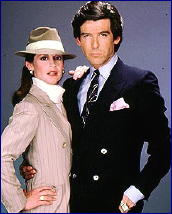
Writing for the series was at its best during the first season. Experienced showrunner Michael Gleason lead a staff destined to create their own series. Joel Steiger (Jake & the Fatman) won the Edgar award for Best Episode in a TV series for “In the Steele of the Night”. Other writers included Glen Gordon Caron (Moonlighting) and Lee David Zlotoff (MacGyver).
The characters were never more believable. Why wouldn’t a con man and a thief (think Cary Grant in It Takes A Thief) give up that life to have fun chasing Laura and accidentally catching bad guys?
Laura’s reaction to the mystery man was what many young women were going through in 1982 as they chose between a career and marriage. Bernice the secretary meant there was someone in the office to deal with clients while everyone else was off solving mysteries. (This would not be true in coming seasons.)
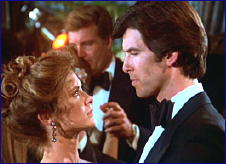
The acting from stars Stephanie Zimbalist and Pierce Brosnan to the guest stars was of the high quality one expected from an MTM Production (Hill Street Blues, St. Elsewhere, etc).
The relationship between Laura and Remington usually featured them battling each other to see who solved the mystery first. Whatever chemistry between the two worked best during this season.
This was the season I developed a crush on Laura Holt, identified with Remington Steele, enjoyed the comedy mysteries, and saw the potential for another special TV series from MTM Productions. While next season’s move from Friday to Tuesday and NBC wanting more slapstick action made the series a hit, it was at the cost of much of what made Remington Steele special during season one.
Oh, if you decide to view an episode of Remington Steele, watch for the MTM kitty salute to a famous detective at the end.
Sat 27 Nov 2010
REVIEWED BY J. F. NORRIS:
R. C. ASHBY – He Arrived at Dusk. Hodder & Stoughton, UK, hardcover, 1933. Macmillan, US, hc, 1933.
Truly a little masterpiece of a book. Reminiscent of Christie at the height of her powers in its brilliant use of misdirection. William Mertoun, an antiquarian, is hired to catalog the estate of a bed-ridden colonel. He is doing this at the behest of the colonel’s nurse and housekeeper, Winifred Goff, a woman who seems terrified of strange poltergeist activities in the house and keeps a close guard on her patient whom she allows no one to see.
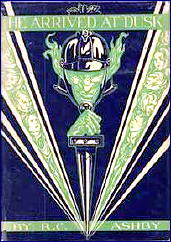
Recently the colonel’s brother fell to his death off a cliff and there is talk that it was no accident. While cataloging the dreary and seemingly worthless library, Mertoun learns from the colonel’s nephew Charles Barr of a local legend. The area is haunted by the ghost of an ancient Roman soldier and the village townspeople are deeply superstitious of it – so much so that no one will set foot on the grounds.
However, Mertoun soon discovers that a brazen shepherd has dared to ignore all the warnings of the townspeople and has set up a home for his flock amid the ruins of the haunted tower a few yards from the Barr estate.
Soon the shepherd is discovered dead – an ancient Roman sword sticking in his back and all believe that the ghost has murdered him.
The supernatural aspects pervade the first third of the book which is narrated by Mertoun who slowly begins to believe in the existence of the ghost – especially after a seance in which something resembling the ghost manifests itself in the manor and later he does see the ghost on the grounds.
He runs to confront it and that is when he discovers the body of the shepherd. And only a few days later the colonel seems to vanish from his room.
The second portion of the novel takes the form of a diary written by Miss Goff’s brother, Hamleth, in which we learn of an investigation into the death of the shepherd and the real reason for the disappearance of the colonel.
Finally the last section is narrated by a Scotland Yard inspector who finally unravels the mystery of the ghost, who killed the shepherd and what happened to the colonel.
What is so remarkable about He Arrived at Dusk is the use of the narrator Mertoun and his perceptions of everything, and the role of Miss Goff behind the scenes, which is perhaps the best part of the book. Much of what occurs is through her orchestration. That it fails to produce what she had intended is no fault of her own.
Really a classic of its kind. One of the best blending of supernatural and detective novel genres written in the 1930s. Interestingly, this pre-dates Du Maurier’s Rebecca by several years and yet has quite a bit of similarity in that book’s use of a frightened narrator whose interpretation of events may or may not always be perfect.
Bibliography: The author’s crime fiction only. Taken from the Revised Crime Fiction IV, by Allen J. Hubin.
ASHBY, R(uby) C(onstance Annie). 1899-1966.
Death on Tiptoe (n.) Hodder 1930.
Plot Against a Widow (n.) Hodder 1932.
He Arrived at Dusk (n.) Hodder 1933.
Out Went the Taper (n.) Hodder 1934.
As Ruby Ferguson, her married name, she became quite well known as the author of a number of children’s “pony books,” among many other works of fiction. See Wikipedia for more information.
J. F.’s review of Death on Tiptoe will appear here on this blog soon.
Fri 26 Nov 2010
REVIEWED BY DARYL S. HERRICK:
THE KANSAN. United Artists, 1943. Richard Dix, Jane Wyatt, Albert Dekker, Victor Jory, Eugene Pallette, Robert Armstrong. Screenplay: Harold Shumate, based on the novel Peace Marshal by Frank Gruber. Director: George Archainbaud.
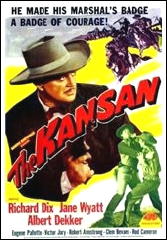
If this review of the 1943 western film The Kansan starring Richard Dix had been published in a newspaper at the time, a sly headline writer may have tried to put this one across: Nix on Dix, He’s No Tom Mix.
The role of the film’s hero, gunplay artist John Bonniwell, fits Dix like a poorly cut, over-sized suit that makes him look ridiculous. He is not as young and fit as a Buster Crabbe or Bob Steele, both of which would have been a better suited for the role, and unlike the older John Wayne in The Shootist, when the husks are peeled away, it is difficult to believe that Dix was ever such a skilled triggerman. Dix fills the role as well as a bloated John Barrymore might have.
What Dix does bring to the role is a modicum of acting ability, and he is successful in his nuanced play with the quasi-villain played by Victor Jory and is charming with the female lead, Jane Wyatt. Jory has the more demanding part and delivers a stronger performance as Jeff Barat, the brother of the irredeemable, crooked banker Steve Barat who masterminds the movie’s machinations.
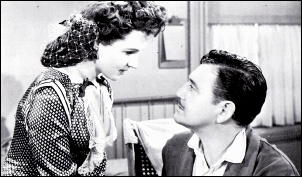
Dix ambles through the movie while the exciting parts like a stampede and all-compassing saloon fight happen around him. Dix is so lugubrious that he brings to mind an insurance salesman apt at dolefully describing death and disaster.
Not as lively as a game of checkers, nor as well thought out as a game of chess, the story moves from one square to the next across a familiar board. Drawn from the novel Peace Marshal by Frank Gruber, Dix’s character John Bonniwell demonstrates his finesse with the pistol and is maneuvered into the marshal’s job by the moneyed Easterner who runs the bank, played by Albert Dekker.
Jory’s character is the gambler brother of the banker and is in love with the woman that Bonniwell loves. The villainous banker brings in his own set of outlaws to balance out the law. Following the same plot that dozens of other bottom-billed Westerns used, the hero cleans up the town and gets his gal.
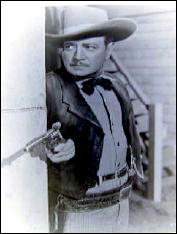
One character, Bones, played by African-American Willie Best, stands out for the wrong reasons. Granted one should be careful about judging attitudes held more than a half century before, but the Bones character with his craven servitude and witless blubbering is a throwback even further to the nastiest caricatures of blacks.
In one scene, the outlaws sarcastically refer to Jory’s character as the Great Liberator and moments later, find the crouching, shivering Bones in his Union soldiers cap; it is as if the movie is almost saying, this is why we have Jim Crow laws.
In a brief key part is the hefty character actor Eugene Pallette, whose voice croaks like a frog and whose bulk and charisma fill the screen in equal proportions. Rushing masses of cattle and horses at various junctures provoke those passions stirred by thundering hooves. A troupe of pretty girls seems to have taken a wrong turn at Times Square as they present their musical number on a saloon stage instead of Broadway.
In that granddaddy of Western talkies, Cimarron (1931), a younger, lithe Richard Dix ably acted the part of Yancey Cravat, but with its playbill opening and grease-painted actors, this earlier film is a thespian production without the constraints of the stage. The recipe for a low-budget Western does not call for a stage actor but a macho movie presence. Dix could muster the former but not the latter.
Thu 25 Nov 2010
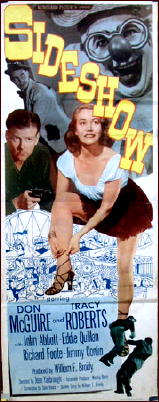
SIDESHOW. Monogram Pictures, 1950. Don McGuire, Tracy Roberts, John Abbott, Eddie Quillan, Ray Walker, Richard Foote, Jimmy Conlin, Iris Adrian. Director: Jean Yarbrough.
This short black-and-white movie (only 67 jam-packed minutes) has some noirish aspects to it – it’s dark throughout (in the sense of poor lighting) and there are a few sinister scenes taking place behind the outward glitter of a rundown carnival – but in reality it’s only a crime film, and not a very good one – not one I can honestly recommend to you, if you can find a copy.
That’s a big “if.” It’s hard to find, and when you do, it’s likely to be in as rough in quality as the one I have. Both the picture and sound deteriorate noticeably toward the end, but not seriously enough to cause you to throw the DVD away. Not me, anyway. I’m happy to have it.
The real problem is that it’s the story itself that falls apart, the longer it goes. I’ve watched the movie twice, and while there was an improvement the second time around, it’s only at the beginning. The ending is still as much of a mystery to me as it was before. Who, what, when, and especially why – all unanswered questions, even after the curtain comes down.
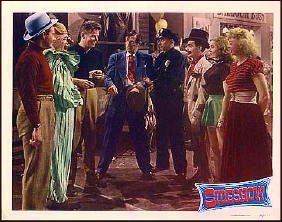
I suppose it’s time for me to tell you what this movie’s about, isn’t it? The amusement park carnival that treasury agent Steve Arthur (Don McGuire) goes undercover working for is also somehow the means by which a gang of jewel thieves has been smuggling their gems into the US. His job: to find out how.
Dolly Jordan (Tracey Roberts), the hootchy-kootchy girl he first suspects, turns out to be both innocent and then a close ally. (The pearls in the fudge she made were placed there by someone else.) But that leaves plenty of other suspects, some brought in during the last reel, and as I said before, the whole affair doesn’t make a lick of sense. (I am not going to watch it a third time.)
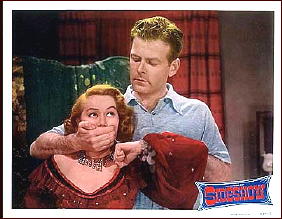
The atmosphere is good, however, including some gritty inside glimpses at sideshow life, and the acting is even better, believe or not.
The hunky Don McGuire, who didn’t star in many other movies, was a lot more successful as a writer (Bad Day at Black Rock, Tootsie), for example, and as a producer and director, while red-headed Tracy Roberts went to become a famous Hollywood acting coach.
Not that you could tell she had red hair in the movie, but I think you can from the poster and at least one of the lobby cards I found for the film.
Thu 25 Nov 2010
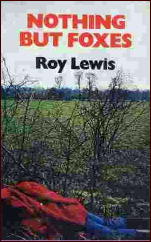
ROY LEWIS – Nothing But Foxes. St. Martin’s, hardcover, 1979. Originally published in England: Collins Crime Club, hardcover, 1977.
Fox hunts are still immensely popular with the English gentry, but not unexpectedly they’ve also become the target of those who view them as outdated elitist symbols of the not yet achieved social equality they clamor for.
When just such a young activist is found murdered, his body discovered by the members of a hunting club in full chase, wise politics suggests that Scotland Yard be called in at once.
Inspector Crow’s usual approach to a murder investigation is a slow and plodding one, as he deliberately takes a cool and dispassionate look at all the evidence before committing himself. Inspired for once, however, by the involved, youthful exuberance of the aspiring young local policeman assisting him, this time he takes a gamble, and he pulls it off.
Disappointingly, the motive has little to do with hunting foxes.
— Reprinted from The MYSTERY FANcier, Vol. 3, No. 5, Sept-Oct 1979. (This review appeared earlier in the Hartford Courant.)
The Inspector John Crow series —
A Lover Too Many (1969)
Error of Judgement (1971)
A Secret Singing (1972)
Blood Money (1973)
A Question of Degree (1974)
A Part of Virtue (1975)
Nothing But Foxes (1977)
A Relative Distance (1981)
Roy Lewis, no relation, and not to be confused with mystery writer Roy Harley Lewis, is not only the author of the eight John Crow mysteries listed above, but 16 books in his Eric Ward series, and 21 crime novels with Arnold Landon as the lead character. Add 12 additional standalones, the most recent being Design for Murder (2010), and you have perhaps one of the more prolific of current writers no one in the US has heard of, without too much exaggeration, I suspect.
Thu 25 Nov 2010
Posted by Steve under
General[2] Comments Thu 25 Nov 2010
REVIEWED BY BARRY GARDNER:
JOHN STRALEY – The Curious Eat Themselves. Cecil Younger #2. Soho Press, hardcover, September 1993. Bantam, paperback, June 1995. Soho Crime, trade paperback, July 2006.
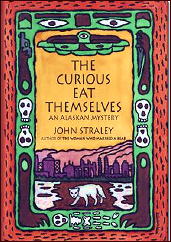
I didn’t read the first Alaskan mystery by John Straley, The Woman Who Married a Bear; it was a conscious avoidance, though I no longer remember why. It sold enough copies that I must have been one of the very few who didn’t, and now he’s written another.
Straley lives in Alaska, is an investigator for the Public Defender and has his own private investigation business; a pretty good set of qualifications.
Cecil Younger is an on-again, off-again drunk, an ex-public defender, and a private investigator. He lives in Ketchikan, Alaska, has an autistic roommate, and his erratic life just took a turn for the worse. His ex-girlfriend had sent a friend to him, who wanted him to track down evidence of her rape by some employees of a big mining concern. Now she’s been fished out of the water with her throat cut. He’s immediately warned off the case by a high ranking official, and old friend of his family. And his roommate’s Labrador has died.
Straley’s book reminds me a little of James Crumley with the alcoholic lead, and the anti-business/environmental orientation, and the flair for describing the wilderness. That’s as far as the comparison goes, because Younger isn’t a macho character, and Straley’s prose hasn’t quite the power of Crumley’s.
It’s good prose, though, and he obviously has a real feel for the Alaskan country about which he writes. He’s a better plotter than Crumley, too.
Aside from the exotic locale, the story itself isn’t that different from many other hardboiled private detective stories, but it’s well told, and the various characters are interesting. A few of the business and government people are a tad one-dimensional, but at least you don’t need a scorecard to tell the villains.
There’s a third in the series already, and I like this one enough that I’ll probably read it. I might even go back and read the first.
— Reprinted from Ah, Sweet Mysteries #10, November 1993.
The Cecil Younger series —
1. The Woman Who Married a Bear (1992)
2. The Curious Eat Themselves (1993)
3. The Music of What Happens (1996)
4. Death and the Language of Happiness (1997)
5. The Angels Will Not Care (1998)
6. Cold Water Burning (2001)
Editorial Comment: Barry seems to have jumped the gun on the forthcoming appearance of the third book. His review was written in 1993, but the third book didn’t appear until 1996.
Next Page »



